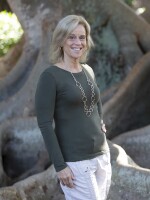On a perfectly manicured practice field at the new Atlanta Braves spring training facility in North Port, dozens of girls from across the country are lined up for batting practice.
They are here for a girls baseball camp, and are being coached by members of the gold medal winning U.S Women’s Baseball World Cup team, players from Canada’s national team, and alumni from the World War II era, All American Girl's Professional Baseball League, which inspired the movie, "A League of their Own."
Baseball has long been called America's "national pastime." But for women and girls, the sport hasn't always been exactly inclusive. This camp, and other initiatives across the country, are aiming to change the perception that baseball is just for boys.
As a player for the All-American Girls Professional Baseball League, Sister Toni Palermo was one of about 600 women to play pro baseball from 1943 to 1954. She played shortstop for the "Chicago Colleens" and the "Springfield Sallies," and was known for her prolific base stealing.
"And every time I would steal a base I had to slide, and I still have scars to prove it,” she said. “So there was no crying in baseball."
Palermo, who is now a Catholic nun, traveled to CoolToday Park from her home in Wisconsin to help coach, as did Jeneane Des Combes Lesko, formerly of the AAGPBL’s Grand Rapids Chicks, who now lives in Seattle.
They are here to support the camp's organizer, Sue Zipay of Englewood, who also played professional baseball. She was with the women's league's winningest team, the Rockford Peaches. Zipay and her son have run the Englewood Tennis Club for over 30 years but baseball has always been her passion. It was Zipay's idea to approach the Braves Florida organization to host the girls-only training event.
“It was an honor to host the first American Girls Baseball camp,” said Michael Dunn, the team’s vice president of Florida operations. “The Braves are always looking to promote the great game of baseball to everyone. It was a wonderful way to do so, and a great reception from players, participants, All American Girls Professional Baseball Association and Braves staff members. We look forward to the next camp or tournament.”
Back in the women's league days, the players were required to attend charm school and they had to wear skirts and make-up when they played.
That all seems pretty crazy to 10-year-old camp goer Olivia Lockhart of Sarasota, a starting pitcher and utility player on Little League's Sarasota American All-Star baseball team.

"I would hate that,” she said. “Cause I hate dresses. I hate skirts and I hate wearing lipstick."
The All-American Girls Professional Baseball League was created by sports owners at a time when thousands of young men were fighting in World War II. Camp coach Kevin Marden, general manager of the New England Women's Red Sox, says it was a way to keep baseball in the public eye.
"In those days, they needed baseball, so guess what? All the good ole' boys found a bunch of women that could play the game and bingo, you had a professional league," he said.
Since then, the sport hasn't evolved much when it comes to equity.
In 1972, an 11-year-old girl named Maria Pepe was forced to quit her team after the national Little League organization threatened to pull her club's charter. Her family sued the organization but by the time the case was settled, she was too old to play Little League.
But Pepe did pave the way for hundreds of young women, including 9-year-old Greta Knierim of New Jersey.
"All I know is Maria Pepe fought for us to make girls start playing baseball,” she said. "And she's technically

my hero because I love playing baseball. It's like my world to me."
Title IX, the 1972 law mandating gender equity in federally funded education programs, grants girls the legal right to a fair tryout for any baseball team. But according to the latest data, almost half a million boys played high school baseball last year, compared to about 1,700 girls.
Coach Kevin Marden says those numbers have nothing to do with a girl's ability to play the game.
“The game dictates whether you can play or not," he said. "Not the gender, the game.”

Today more than 100,000 girls play youth baseball nationwide, according to Baseball For All, a nonprofit organization that promotes girls' participation in the sport.
Even so, all of the coaches at girls baseball camp say that at a certain age, girls are encouraged to switch out baseball for softball. That sport has infrastructure and high school teams. Also, college scholarships are at stake.
Currently there are nearly 300 NCAA Division 1 softball programs at colleges across the country.
Coach Sister Toni Palermo says she just wants girls to have options.
“I have nothing against softball because I played professional softball too,” she said. “But if they choose to play baseball, they should have the right."
But back at girls baseball camp, on at least this day, these young women aren't even trying to make a statement.
They just want to play ball.





















